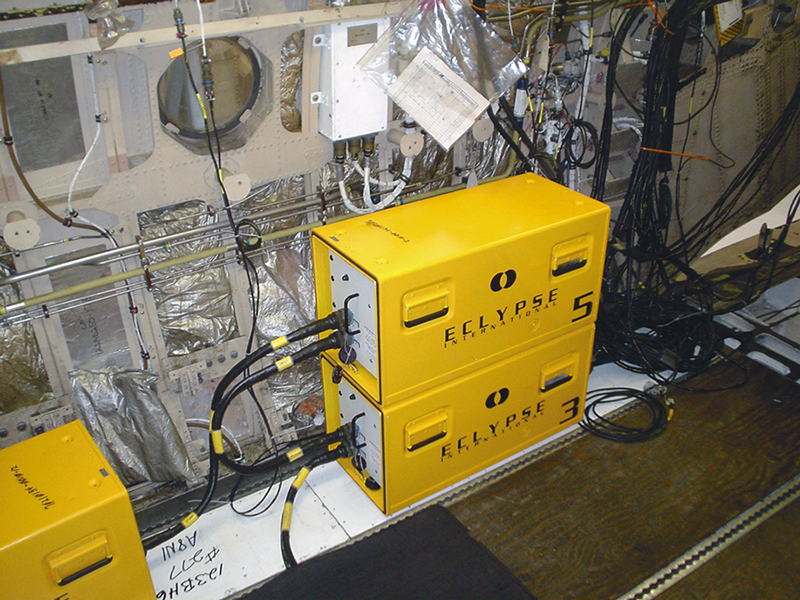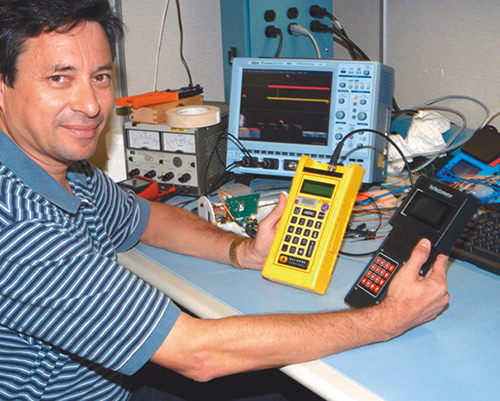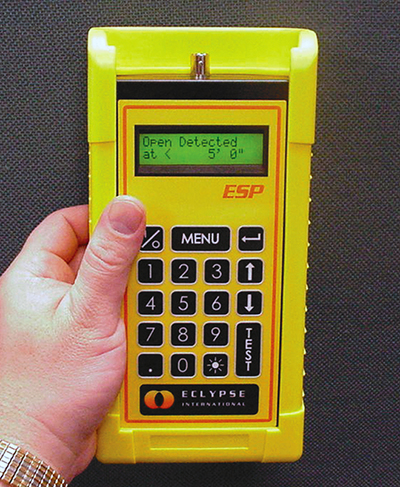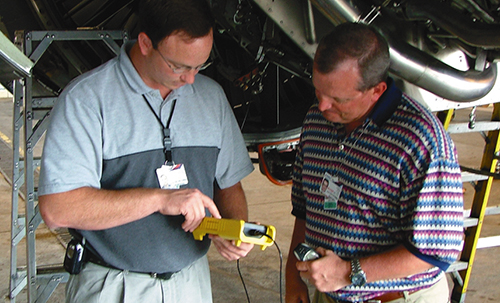
Technology That’s Ready and Able to Inspect Those Cables
Originating Technology/NASA Contribution
Attempting to locate a malfunctioning wire in a complex bundle of wires or in a cable that is concealed behind a wall is as difficult as trying to find a needle in a haystack. The result of such an effort can also be costly, time-consuming, and frustrating, whether it is the tedious process of examining cable connections for the Space Shuttle or troubleshooting a cable television hookup. Furthermore, other maintenance restrictions can compound the effort required to locate and repair a particular wiring problem. For example, on the Space Shuttle, once a repair is completed, all systems that have a wire passing through any of the connectors that were disconnected during troubleshooting are affected and, therefore, must undergo retesting—an arduous task that is completely unrelated to the original problem.
In an effort to streamline wire inspection and maintenance, two contractors supporting NASA’s Kennedy Space Center invented the Standing Wave Reflectometer (SWR) in 1999. In doing so, they leveraged technology that was first developed to detect problems that could lead to aircraft accidents, such as the one that resulted in the catastrophic failure of TWA flight 800 in 1996. The SWR performs a non-intrusive inspection that verifies the condition of electrical power and signal-distribution systems inside the Space Shuttle orbiters. Such testing reduces processing delays and ensures safe operation of these systems.
Commercial non-intrusive cable testers that preceded the SWR proved ineffective for wire examination on the Space Shuttle, because of the high-frequency test signals they produced. These signals were incapable of penetrating the dedicated signal conditioners (DSCs) that are used on the Space Shuttle to modify transducer outputs and other signals to make them compatible with orbiter telemetry, displays, and data-processing systems. Recognizing that the need for a low-frequency test was critical to the success of the Space Shuttle, the inventors of the SWR ensured NASA that their hand-held technology could easily pass through DSCs without any interference from signals outside of the intended bandwidth.
When troubleshooting potential instrumentation problems in the orbiter, NASA technicians use the SWR tester to find the precise location of a short or open circuit in a cable. This ability saves NASA many hours of testing on Space Shuttle by minimizing repair, retest time, and any future troubleshooting efforts.
Eclypse International Corp., a leading developer of automated test equipment and associated test application software solutions for commercial and military organizations worldwide, further developed the SWR for use outside of NASA. The resulting technology is currently being used to test wires and cables in complex vehicle systems, and has the potential for myriad consumer-driven applications, as it features a menu-driven interface simple enough for a novice to use.
Partnership
Kennedy’s Technology Transfer Office partnered with the Research Triangle Institute and the Southeast Regional Technology Transfer Center at the University of Florida to market the patented SWR technology. The Technology Transfer Office held a briefing at Kennedy, where the SWR technology was demonstrated to more than 50 manufacturers of electronic test equipment, including Corona, California-based Eclypse. Following the briefing, each of the participating manufacturers submitted a license application that included a developmental plan and a market-application plan. Eclypse, which had been exploring useful hand-held troubleshooting tools that could augment and assist maintenance personnel in locating short- and open-circuited wiring in aviation vehicles, was awarded the exclusive patent rights to the NASA SWR technology. Eclypse felt that the SWR would provide a reasonable, low-cost design concept with capabilities not found in the higher-priced cable reflectometers that were currently available.
Two key factors contributed to Eclypse’s successful procurement of the exclusive NASA license. First was an open-architecture design concept that would allow for the integration of future technologies into the device, and second was a requirement that would provide the company with access to the principal inventor of the SWR during the beginning stages of product development. Eclypse believed that involvement of key personnel during development of its ESP commercial fault location analyzer was vital for establishing an effective busines-plan for the product.
Product Outcome
Although the ESP tag for Eclypse’s commercial hand-held tester does not stand for “extrasensory perception,” the product comes pretty close to having a “sixth sense” in the way that it detects electrical malfunctions with speed and precision. The company claims that the ESP is the fastest and easiest-to-use hand-held wire tester available today.
Eclypse has developed three configurations of its ESP product line based upon NASA’s SWR technology. The original model, the ESP, provides a basic tool to locate hard faults, such as opens and shorts, and has proven to be very effective for reactive maintenance events. This tool is preferred by commercial airlines. The second-generation model, ESP+, retains all of the features of the original, but also contains a flash memory that allows the operator to store 32 test waveforms that can be uploaded to any personal computer for comparison and analysis. The ESP+ is preferred by military and aerospace organizations for its data-collection capability. The third configuration, the ESP Scientific model, is a 100 MHz, +/- 250VDC version of the ESP. This model provides a loading capability that has proven to be very effective in detecting “soft” faults, such as corrosion and degradation defects that can happen prior to a wire breaking.
The ESP family of hand-held SWR meters provides the means to determine the nature and location of discontinuity in a cable by monitoring the impedance while injecting an oscillating signal at one end of a cable and varying the frequency of the oscillating signal. A numerically controlled oscillator generates the signal, and a microprocessor automatically makes the desired measurements and displays the results.
Eclypse has made many improvements to the original NASA prototype hand-held device. The NASA prototype was physically large, fragile, and required specific hexadecimal keypad entries to perform limited functions. In contrast, the ESP weighs only 1 pound, 3 ounces, and measures a mere 4 inches wide, 8 inches high, and 1 inch deep. (NASA has since replaced its hand-held tester with the ESP for Space Shuttle maintenance and test requirements.) Additional features integrated by Eclypse include an alphanumeric, selectively back-lighted liquid crystal display and keypad, a rechargeable battery, automatic shutoff power management, a serial data port, and a drip/splash-proof and shock-resistant case.
The ESP has a specified range of 1,000 feet and can operate successfully in temperatures ranging from -20 to +60 ºC. It also provides the capability to store 99 programmable settings for various cable and conductor types, including coaxial, triaxial, multistrand single conductor, and twisted pair. These presets can be recalled quickly for testing, using the simple menu-driven interface. Best of all, the ESP presents solutions in plain English language and does not require visual waveform analysis to determine the cause and location of a discontinuity.
The ESP meter will benefit any industry that generates, distributes, or consumes electrical energy to control processes. Commercial customers include Emerson Network Power, a manufacturer of precision-controlled, uninterruptible power systems that include air conditioning and fluid cooling systems, and APW Ltd., a designer, manufacturer, and integrator of electronic products. In aerospace and aviation, Boeing Aircraft, Lockheed Martin Corporation, Delta Airlines, and Continental Airlines have applied the technology.
At Seymour Johnson Air Force Base in North Carolina, the 4th Component Maintenance Squadron is writing software programs for the ESP tester to troubleshoot aircraft wiring within 3 minutes, as opposed to the 20-plus hours sometimes needed to manually complete such a task with a conventional multimeter.
“The Eclypse tester is more accurate, faster, and easier to use than anything I’ve seen, and we simply can’t build anything that can do what it can in this shop,” claimed Master Sergeant Stephen Hoggard, 4th Component Maintenance Squadron chief, electronic and environmental section.
In another military application, the ESP+ model is ensuring the safety of U.S. troops serving overseas. In October 2004, a U.S. EA-6B Prowler aircraft deployed in Bagram, Afghanistan, required extra attention, because of intermittent navigational problems within a critical cockpit display panel. These problems occurred multiple times on nearly every flight, though were rarely observed on deck during routine troubleshooting exercises. Most importantly, they compromised the safety of flight, since the plane was flying in a war zone, through mountainous terrain at night.
The U.S. squadron maintaining the Prowler aircraft troubleshot the problem for weeks, changing all associated removable components and performing wire checks, all without success. To add to the difficulty, documentation detailing the circuits for the problematic display panel was not available.
To facilitate further troubleshooting, the squadron decided to remove the wing skin panels and expose the wire bundle containing the suspect circuits, so that the bundle could be physically manipulated while under electrical test.
The squadron tested the exposed wires with a common digital multimeter, a time domain reflectometer, and then a hipot insulation-resistance tester, but could not determine the “culprit” wire. Next, it performed a test with the ESP+ meter, and the faulty wire that was the root of the navigational problems was revealed. The wire was replaced and the problem was solved. The success with the ESP+ motivated the squadron to use the meter to identify several other long-standing discrepancies on other aircraft.
The ESP Scientific model is currently used by the Federal Aviation Administration for impedance spectroscopy (measuring corrosion rates) and is preferred by formidable research teams that include U.S. military branches, NASA, and aerospace firms.
All three ESP products are assuaging White House Office of Science and Technology Policy (OSTP) concerns about aging wiring. The OSTP concludes that such issues extend beyond aviation and are of national concern, while referring to the SWR-spinoff technologies as “intelligent systems for identifying faults.”
On the whole, the economic benefits derived from the application of SWR technology include: lower investment costs of troubleshooting equipment; reduced time and effort to affect repairs; reduced time to validate repairs; and avoidance of failure-induced downtime, all of which result in lower total operating cost.

Pedro Medelius, chief technologist for ASRC Aerospace Corp., helped invent the Standing Wave Reflectometer (in right hand). The commercial version of this device (in left hand) was spun off by Eclypse International Corp.

The Eclypse hand-held, non-intrusive analyzer finds the precise location of a short or open circuit in a cable.

Delta Airline technicians Dane Swenson and Jim Elick use the Eclypse analyzer to test generator feeders on a Boeing 767 commercial aircraft.

The C-2 Greyhound full aircraft circuit-analysis test at North Island Naval Air Depot, Coronado, California.













